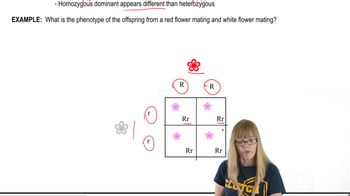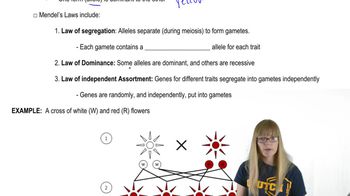Table of contents
- 1. Introduction to Genetics51m
- 2. Mendel's Laws of Inheritance3h 37m
- 3. Extensions to Mendelian Inheritance2h 41m
- 4. Genetic Mapping and Linkage2h 28m
- 5. Genetics of Bacteria and Viruses1h 21m
- 6. Chromosomal Variation1h 48m
- 7. DNA and Chromosome Structure56m
- 8. DNA Replication1h 10m
- 9. Mitosis and Meiosis1h 34m
- 10. Transcription1h 0m
- 11. Translation58m
- 12. Gene Regulation in Prokaryotes1h 19m
- 13. Gene Regulation in Eukaryotes44m
- 14. Genetic Control of Development44m
- 15. Genomes and Genomics1h 50m
- 16. Transposable Elements47m
- 17. Mutation, Repair, and Recombination1h 6m
- 18. Molecular Genetic Tools19m
- 19. Cancer Genetics29m
- 20. Quantitative Genetics1h 26m
- 21. Population Genetics50m
- 22. Evolutionary Genetics29m
2. Mendel's Laws of Inheritance
Mendel's Experiments and Laws
Problem 38a
Textbook Question
Draw a pedigree containing two parents and four children. Both of the parents have AB blood type. The first child is type A, the second child is type AB, and the third child is type B.
The fourth child tests as having blood type O, which is not possible given the parental genotypes. Look at Figure 4.4 and read the description of the molecular process that generates ABO blood group antigens. What other mutation could account for this observation?
 Verified step by step guidance
Verified step by step guidance1
<span>Step 1: Understand the ABO blood group system. The ABO blood group is determined by the presence of antigens on the surface of red blood cells. The alleles involved are I<sup>A</sup>, I<sup>B</sup>, and i. I<sup>A</sup> and I<sup>B</sup> are codominant, while i is recessive.</span>
<span>Step 2: Analyze the parental genotypes. Both parents have AB blood type, meaning their genotypes are I<sup>A</sup>I<sup>B</sup>. This means they can pass either the I<sup>A</sup> or I<sup>B</sup> allele to their offspring.</span>
<span>Step 3: Determine the possible genotypes of the children. The possible combinations from two I<sup>A</sup>I<sup>B</sup> parents are I<sup>A</sup>I<sup>A</sup> (Type A), I<sup>A</sup>I<sup>B</sup> (Type AB), I<sup>B</sup>I<sup>B</sup> (Type B), and I<sup>A</sup>I<sup>B</sup> (Type AB). Type O (ii) is not possible from these parents.</span>
<span>Step 4: Consider the molecular process of ABO antigen formation. The ABO blood group antigens are formed by the addition of specific sugars to the H antigen on the red blood cell surface. A mutation affecting this process could lead to a discrepancy in expected blood type.</span>
<span>Step 5: Hypothesize a mutation. A possible explanation for the Type O blood type in the fourth child could be a mutation in the FUT1 gene, which is responsible for the formation of the H antigen. Without the H antigen, the ABO antigens cannot be expressed, resulting in a phenotype similar to Type O.</span>
Recommended similar problem, with video answer:
 Verified Solution
Verified SolutionThis video solution was recommended by our tutors as helpful for the problem above
Video duration:
2mPlay a video:
Was this helpful?
Key Concepts
Here are the essential concepts you must grasp in order to answer the question correctly.
ABO Blood Group System
The ABO blood group system is determined by the presence of antigens on the surface of red blood cells. There are four main blood types: A, B, AB, and O, which result from the combination of alleles A and B. Type O individuals lack A and B antigens, while AB individuals express both. Understanding this system is crucial for analyzing inheritance patterns and potential blood type outcomes in offspring.
Recommended video:
Guided course

Variations on Dominance
Inheritance Patterns
Inheritance patterns describe how genetic traits are passed from parents to offspring. In the case of blood types, both parents with AB blood type can pass on either A or B alleles, leading to possible offspring with types A, B, or AB. However, type O cannot be produced from two AB parents under normal Mendelian inheritance, indicating the need to explore other genetic factors or mutations.
Recommended video:
Guided course

Organelle Inheritance
Genetic Mutations
Genetic mutations are changes in the DNA sequence that can lead to variations in traits. In the context of blood types, a mutation could potentially alter the expression of blood group antigens, allowing for unexpected phenotypes like type O in the offspring of AB parents. Understanding the role of mutations is essential for explaining anomalies in genetic inheritance and phenotypic expression.
Recommended video:
Guided course

Mutations and Phenotypes

 8:06m
8:06mWatch next
Master Mendel's Experiments with a bite sized video explanation from Kylia Goodner
Start learningRelated Videos
Related Practice



